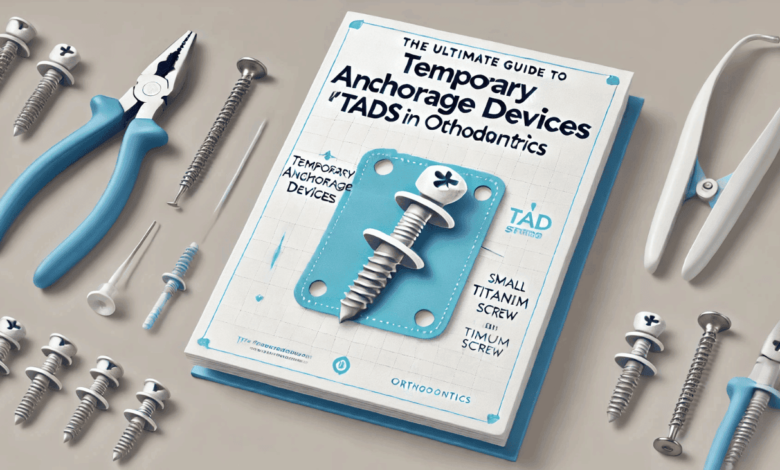The Ultimate Guide to Temporary Anchorage Devices (TADs) in Orthodontics

Orthodontics has evolved significantly over the years, introducing innovative techniques that improve treatment efficiency and patient comfort. One such advancement is the temporary anchorage device (TAD). This small but powerful tool has transformed the way orthodontists correct misalignments and enhance treatment outcomes. If you’re considering orthodontic treatment or simply want to understand how TADs work, this article provides an in-depth look at their purpose, benefits, and procedure.
What is a Temporary Anchorage Device?
A temporary anchorage device is a small titanium screw that is temporarily implanted into the jawbone to serve as an anchoring point for orthodontic movement. Unlike traditional braces, which rely on adjacent teeth for support, TADs provide a stable, independent anchor that allows for more controlled tooth movement. They are typically used in complex cases where traditional methods may not be sufficient.
How Does a Temporary Anchorage Device Work?
TADs function as a fixed point against which teeth can be moved. The device is placed into the bone and connected to braces or aligners using elastics or wires. This helps in achieving precise tooth movement without affecting neighboring teeth. Since they are made of biocompatible titanium, they integrate well with the bone and minimize the risk of rejection or complications.
Benefits of Using a Temporary Anchorage Device
Faster Treatment Time
Since TADs provide a direct anchorage point, they allow for more efficient tooth movement, often reducing overall treatment duration.
Minimally Invasive Alternative
In many cases, TADs eliminate the need for extractions, surgery, or headgear, making treatment less invasive.
Greater Precision
Orthodontists can achieve complex tooth movements with better control, leading to more predictable results.
Enhanced Comfort
Compared to traditional external headgear, TADs offer a more comfortable and discreet solution.
Versatility
TADs can be used in various cases, including correcting overbites, closing gaps, and aligning impacted teeth.
The Process of Placing a Temporary Anchorage Device
The procedure to place a TAD is quick and relatively painless. Here’s what you can expect:
Consultation & Planning
The orthodontist evaluates the patient’s needs and determines whether a temporary anchorage device is necessary.
Placement Procedure
A local anesthetic is applied to numb the area, and the TAD is gently inserted into the jawbone using a specialized hand tool.
Healing & Maintenance
Patients may experience mild discomfort for a day or two, which can be managed with over-the-counter pain relievers. Proper oral hygiene is crucial to prevent infection.
Removal
Once the treatment goal is achieved, the temporary anchorage device is removed in a simple, painless procedure without requiring anesthesia.
Who Can Benefit from a Temporary Anchorage Device?
TADs are particularly useful in cases where traditional orthodontic methods may not be enough. Some common scenarios include:
- Patients with severe misalignments that require significant tooth movement.
- Individuals with missing teeth where traditional anchorage points are unavailable.
- Cases where headgear was traditionally used but is now replaced with TADs for a more aesthetic and comfortable alternative.
Are There Any Risks Associated with TADs?
While temporary anchorage devices are generally safe, some minor risks include:
Mild Discomfort
Some patients experience minor soreness after placement, but this typically subsides within a few days.
Loosening of the Device
In rare cases, the TAD may become loose and need repositioning.
Infection Risk
Proper oral hygiene and regular check-ups minimize the risk of infection.
Caring for a Temporary Anchorage Device
To ensure the success of TAD treatment, follow these care tips:
- Maintain excellent oral hygiene by brushing and flossing regularly.
- Use an antibacterial mouthwash to prevent infections.
- Avoid touching or playing with the device to prevent loosening.
- Attend regular check-ups to monitor progress and ensure the TAD remains in place.
Frequently Asked Questions (FAQs)
Do Temporary Anchorage Devices Hurt?
The placement process is virtually painless since local anesthesia is used. Some mild discomfort may occur after placement, but it usually resolves within a few days.
How Long Do Temporary Anchorage Devices Stay In?
TADs are typically used for a few months to a year, depending on the orthodontic treatment plan.
Can I Eat Normally with a Temporary Anchorage Device?
Yes, but it is recommended to avoid hard, sticky foods that could dislodge the device.
Are TADs Visible?
They are small and discreet, often placed in areas that are not easily noticeable.
What Happens If a TAD Becomes Loose?
If a TAD loosens, your orthodontist can easily reposition or replace it without complications.
Conclusion
A temporary anchorage device is an invaluable tool in modern orthodontics, offering precision, efficiency, and comfort. Whether you need significant tooth movement or want to avoid invasive procedures, TADs provide a reliable solution. If you’re considering orthodontic treatment, consult with an experienced orthodontist to see if a TAD is the right option for you.
By understanding how a temporary anchorage device works and its numerous benefits, you can make an informed decision about your orthodontic care. Embracing advanced solutions like TADs can lead to faster, more comfortable, and highly effective treatments, bringing you one step closer to a perfect smile.



